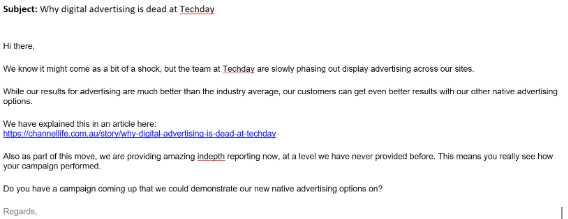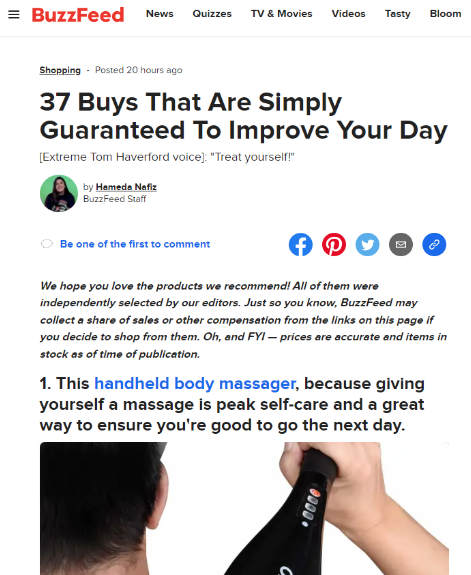Share

A month or so ago this landed in my email from leading technology news network Techday informing readers that it was phasing out display advertising across its sites as other native advertising options were performing much better.

However, rather than coming as a shock (as the EDM suggests it might) it was actually more of a validation as it reflects the conversations we are having with many of our customers. Digital advertising is inherently broken and publishers and brands alike are embracing alternative customer acquisitions channels.
Why digital ads aren’t working
I should have added “unless you are Facebook or Google” to the title above. One of the main challenges facing publishers is the overwhelming majority of new ad dollars are going to Facebook and Google. Last year’s ACCC did an inquiry into digital platforms. It found that in 2019, every $100 spent in ads, $53 went to Google, $28 to Facebook and $19 to other sites and ad tech.
But the problem runs deeper than the alpha publishers’ effective monopoly on digital ad spend. It’s also down to the fact that consumers are ignoring, blocking and losing patience with digital advertising. Driven by a decline in trust it’s also fuelled by data privacy concerns. There’s irritation at slow to load ads and clunky creatives. This is not to mention being chased around the internet by the same pair of jeans you searched for once. The reality is that publishing houses are seeking new ways of helping brands reach consumers. As Techday noted, “Almost half of our readers don’t see advertising. Of those who do see advertising, most are conditioned to ignore or avoid it.”
The rise of the commerce content model
Publishers are finding success with a number of alternative models that have content at the heart. Native content or branded content and – increasingly commerce content.
Commerce content is a fairly catch all term for when brand advertisers partner with publishers to create different types of shopping experiences for them – whilst upholding editorial values.
This can be things like gift guides on sites like Buzzfeed or Yahoo!:

Or editorial marketplaces like New York magazine’s The Strategist. This is a natural extension from the parent magazine which seeks to guide people to make everyday purchases. Similarly, buyer’s guides, comparison sites and how-to sites which help shoppers make informed decisions. Finder is gaining enormous traction as it provides utility and value to the publisher, advertiser and consumer.
And of course, these types of partnerships can be extended. It can go to much smaller publishers or individual influencers like YouTube creators and microbloggers.
In content we trust
These types of content partners are working for all parties, because they put trust at the centre of things. Publishers have built up trust with their audience who value their opinions and reviews. Commerce content partnerships then leverage – and safeguard – this trust to provide value and utility to consumers. They do this by only working with brands or products that are a genuinely good fit for their audience. It’s a false economy for publishers or content providers to work with brands that feel inauthentic and at risk of losing subscribers, readers or followers if they strike a false note.
Most publishers and creators have more loyalty to their audience and customers than to any brand they may talk about. They are trying to make informative content for their audience, and in an authentic way, because that’s what consumers will ultimately discover anyway. This means you will often see publishers or creators describing aspects of products they dislike, as well as like.
Consequently, brands who enter into these types of partnerships must accept that they can’t retain full control of the narrative and embrace others talking or writing more authentically about their product or service. But the pay-off is the ability to move away from lower return CPM advertising models and the ability to connect with an engaged audience in a trusted environment.
Scaling content partnerships
For both publishers and brand advertisers the right tools and technology now exist to establish and manage all kinds of partnerships. Partnership management technology now makes it incredibly easy for brands. It allows brands to discover, manage, reward and optimise publisher and influencer partnerships. It allows brands to more easily create alternate revenue streams for publishers and incremental revenue for brands.
As the ads (increasingly) don’t work, it’s a good time for both brands and publishers alike to embrace the benefits of commerce content partnerships.
Ayaan Mohamud is the regional vice president, Marketing – APAC at impact.com.















